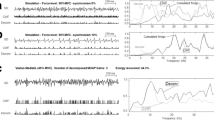Abstract
The generation of an e.m.g. can be modelled by linear filtering of N impulse trains, regarded as the neural inputs to N motor units, where the e.m.g. is the sum of the outputs of the N filters. Starting from this model, it is shown that not only are the shapes of the N action potential images as viewed by the electrodes an important factor in defining the spectrum, but so is the interspike interval distribution of the impulse trains. Changes in the statistics of the pulse trains are shown to affect the low-frequency end of the power spectrum even if the motor-unit action potentials do not change shape. The effect is illustrated by use of data already published on deltoid muscle and brachii biceps. A means of including motor-unit synchronisation is introduced and it is shown that its effect can be contrary to that due to the firing statistics.
Sommaire
La génération d'un électromyogramme peut être mise en modèle par le filtrage linéaire des trains d'impulsionsN, considérés en tant qu'entrées neurales des unités motricesN, ou l'e.m.g. représente la somme des sorties des filtresN. En prenant ce modèle comme point de départ, on peut constater que non seulement les configurations des images potentielles de l'actionN, vues par les électrodes, représentent un facteur important pour l'établissement de la définition du spectre d'électromyogramme, mais que la distribution des intervalles entre-crête des trains d'impulsions le sont également. Similairement, on peut constater que les modifications d'ordre statistique des trains d'impulsions affectent l'extrémité de basse-fréquence du spectre de puissance, même si les potentiels actifs de l'unité motrice ne changent pas de configuration. Cet effet est illustré par l'utilisation de donées déjà publiées qui se rapportent aux aspects des muscles deltoides et des bicep brachiaux. Une méthode est également présentee, qui consiste à incorporer la synchronisation de l'unité motrice et, à cet égard, on constate que l'effet de cette dernière peut être possiblement à l'inverse de celle qui est engendrée par les statistiques des temps d'allumage.
Zusammenfassung
Die Erzeugung eines EMG kann durch lineares Filtern einerN-Impulsserie im Modell dargestellt werden, die als neurale Eingaben fürN-motorische Einheiten angesehen werden, wobei das EMG die Summe der Ausgaben von denN-Filtern ist. Ausgehend von diesem Modell wird gezeigt, daß die Formen der durchN-Wirkung hervorgerufenen Potentialbilder, die von den Elektroden abgelesen werden, nicht nur einen bedeutenden Faktor in der Begrenzung des Spektrums darstellen, sondern daß dies auch für die Intervall- verteilung der Impulsserien zwischen den Spitzen zutrifft. Änderungen inder Statistik der Impulsserien wirken sich erwiesenermaßen auf die Nieder-frequenzseite des Kraftspektrums aus, selbst wenn die Aktionspotentiale der motorischen Einheiten ihre Form nicht ändern. Die Wirkung wird durch Einsatz von bereits veröffentlichten Daten über den Deltamuskel und die Brachialmuskeln dargestellt. Ein Mittel zum Einschluß der Synchronisation von motorischen Einheiten wird vorgestellt, und eswird gezeigt, daß seine Wirkung entegengesetzt zur Auslösungsstatistik liegen kann.
Similar content being viewed by others
References
Birö, G. andPartridge, L. D. (1971) Analysis of multiunit spike records.J. Appl. Physiol. 30, 521–526.
Brody, G., Scott, R. N. andBalasubramanian, R. (1974) A model for myoelectric signal generation.Med. & Biol. Eng. 12, 29–41.
Clamann, H. P. (1969) Statistical analysis of motor unit firing patterns in human skeletal muscle.Biophys. J. 9, 1233–1251.
Coggshall, J. C. (1973) Linear models for biological transducers and impulse train spectra: General formulation and review.Kybernetik 13, 30–37.
Cox, D. R. (1962)Renewal theory. Methuen, London.
Cox, D. R. andSmith, W. L. (1954) On the superposition of renewal processes.Biometrika 41, 91–99.
De Luca, C. J. andForrest, W. J. (1973) Some properties of motor unit action potential trains recorded during constant force isometric contraction in man.Kybernetik 12, 160–168.
De Luca, C. J. andVandyk, E. J. (1975) Derivation of some parameters of myoelectric signals recorded during sustained constant force isometric contractions.Biophys. J. 15, 1167–1180.
Fay, D. F., Jones, N. B. andPorter, N. (1976) Spectral analysis of the myoelectric activity of the pelvic floor during voluntary contractions.Electromyography & Clin. Neurophysiol. 16, 525–551.
Gestri, G. (1972) Autocorrelation and spectrum of the modulated retinal discharge. A comparison of theoretical and experimental results.Kybernetik 11, 77–85.
Johansson, S., Larsson, L. E. andOrtengren, R. (1970) An automated method for the frequency analysis of myoelectric signals evaluated by an investigation of the spectral changes following strong sustained contractions.Med. & Biol. Eng. 8, 257–264.
Kadefors, E. K., Kaiser, E. andPetersen, I. (1968) Dynamic spectrum analysis of myoelectric potentials with special reference to muscle fatigue.Electromyography 8, 39–74.
Khintchine, A. Y. (1960)Mathematical methods in the theory of queueing. Charles Griffin, London.
Larsson, L. E. (1969) Frequency analysis of the EMG as used in practical clinical work.Electroenceph. & Clin. Neurophysiol. 26, 338–343.
Libkind, M. S. (1968) II Modelling of interference bioelectrical activity.Biophys. 13, 811–821.
Libkind, M. S. (1969) III Modelling of interference bioelectrical activity.14, 395–398.
Lindstrom, L., Magnusson, R. andPetersen, I. (1970) Muscular fatigue and action potential conduction velocity changes studies with frequency analysis of EMG signals.Electromyography 10, 341–356.
O'Donnell, R. D., Rapp, J., Berkhout, J. andAdey, W. R. (1973) Autospectral and coherence patterns from two locations in the contracting biceps.Electromyography Clin. Neurophysiol. 13, 259–269.
Person, R. S. andMishin, L. N. (1964) Auto and cross-correlation analysis of the electrical activity of muscles.Med. & Biol. Eng. 2, 155–159.
Shiavi, R. andNegin, M. (1975) Multivariate analysis of simultaneously active motor units in human skeletal muscle.Biol. Cybernetics 29, 9–16.
Shiavi, R. andNegin, M. (1975a) Stochastic properties of motor-neuron activity and the effect of muscular length.19, 231–237.
Zadeh, L. A. (1957) Signals flow graphs and random signals.Proc. IRE 45, 1413–1414.
Author information
Authors and Affiliations
Rights and permissions
About this article
Cite this article
Lago, P., Jones, N.B. Effect of motor-unit firing time statistics on e.m.g. spectra. Med. Biol. Eng. Comput. 15, 648–655 (1977). https://doi.org/10.1007/BF02457923
Received:
Accepted:
Issue Date:
DOI: https://doi.org/10.1007/BF02457923



